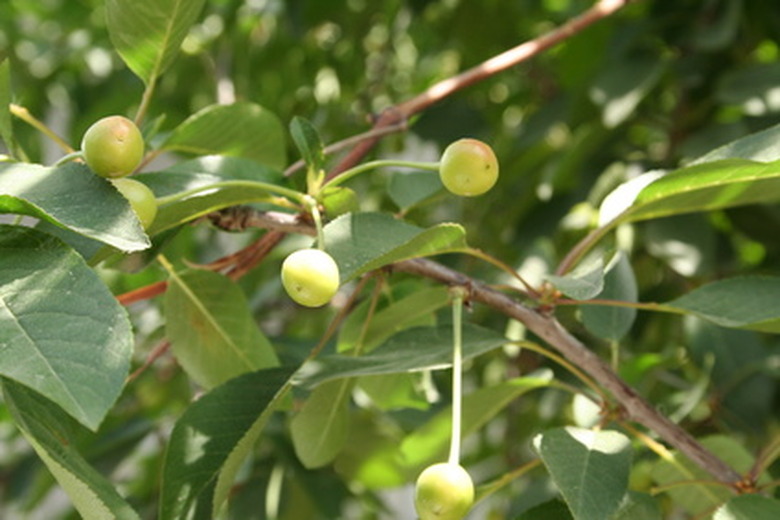What Cherry Trees To Grow In Colorado
Both sour cherries, hardiness zones 4 through 8, and sweet cherries, hardiness zones 5 through 8, can be grown in the state of Colorado provided the trees are planted in full sun in well-drained soil. Sweet cherries grow better in the western, mountainous part of Colorado, although a few of these types can also be grown in urban, eastern areas as well. In the eastern part of Colorado, which is part of the Great Plains, sour cherries are dependable producers.
Western Rural and Urban Areas
Sweet cherries have a warmer growing range, making the western part of Colorado favorable for planting these types. Keep in mind that sweet cherry trees require another tree for pollination and that not all trees will cross-pollinate. The exceptions are Index, Lapins, Stella and Sweetheart, all self-pollinators that work well for those looking to plant one tree, according to the Colorado State University Extension.
Eastern Rural Areas
Sour cherry trees are not only self-pollinators, but are suited for cooler climates like those found in eastern Colorado. Good sour cherry varieties include Montmorency, Early Richmond, Hansen bush cherry, Nanking, Meteor and Montmore. In addition to being self-fertile, North Star and English Morello are double-duty trees because they flower late and pollinate cherry trees that need a partner, according to Alan Buckingham in his book, "Grow Fruit."
- Both sour cherries, hardiness zones 4 through 8, and sweet cherries, hardiness zones 5 through 8, can be grown in the state of Colorado provided the trees are planted in full sun in well-drained soil.
- Sweet cherries have a warmer growing range, making the western part of Colorado favorable for planting these types.
Eastern Urban Areas
Urban areas tend to be warmer than surrounding rural areas, due to the urban heat island effect, according to Windows to the Universe, and the cities in eastern Colorado are no exception. Adventurous fruit tree growers can take advantage of the slightly warmer temperatures by planting compatible sweet cherry trees, keeping in mind the rules on self-pollination.
Grow Cherry Trees In California
California is a top cherry producing state, though cherries thrive only in areas such as Central Coast, San Joaquin Valley and Sierra Nevada foothill areas that meet minimum "winter chill" requirements. Test the soil pH. Add any amendments as needed to achieve a slightly acidic soil, in the 6.2 to 6.8 range. Plant cherry cultivars that do well in California, including tart or "pie cherry" trees such as Early Richmond, North Star, Meteor and Montmorency. Plant well-grown 1-year-old trees as early in spring as the ground can be worked. Place the tree in the center of the hole. Water thoroughly to settle that soil. Remove all branches that form narrow angles with the central leader. Irrigate when weather warms and trees are growing, providing at least 5 to 10 gallons of water per week per tree–more in very hot weather. Mulch to a depth of 4 inches within the tree's dripline, or the outer edge of its leaf canopy. Keep the mulch from touching the tree trunk.
- Urban areas tend to be warmer than surrounding rural areas, due to the urban heat island effect, according to Windows to the Universe, and the cities in eastern Colorado are no exception.
- Adventurous fruit tree growers can take advantage of the slightly warmer temperatures by planting compatible sweet cherry trees, keeping in mind the rules on self-pollination.
References
- "Grow Fruit"; Alan Buckingham; 2010
- U.C. Statewide Master Gardener Program: Cherry
- University of California Extension: California Climate Zones for Temperate Tree Fruits & Nuts
- University of California Extension: Fruit Trees: Planting and Care of Young Trees
- Oregon State University Extension: Growing Quality Cherries
- Virginia University Extension: Growing Cherries in Virginia
